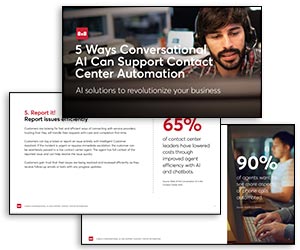Karina Howell at 8×8 asks if now is the time for your contact centre to adopt video.
Do you remember when video communications were NOT part of our daily lives? If your memories of that time are getting dim, you’re not alone.
It’s only been a few years since the pandemic brought about a revolution in how we communicate, but frankly, it feels much longer.
It’s definitely no exaggeration to say that the time when high-touch interactions meant using either phone or in-person communications is in the past. Video has become the standard in both our personal and work lives.
Interestingly, one area of business communications—the contact centre—stands out as relatively slow to embrace video as a channel for customer interactions.
That said, we are seeing an uptick in interest among our customer base. This tracks with the surge in interest in visual communications, including screen share and video, noted by Metrigy Research.
For businesses committed to retaining a competitive edge with superior CX, this leads to a question: is it time to adopt video in your contact centre?
Now Is the Time
The simple answer: yes! contact centre leaders should start to consider adopting the channel. Since consumers are habituated to interacting using video, they increasingly expect to access visual communications for customer service.
Video brings the ability to more quickly resolve complex issues, leading to improvement in key success metrics such as first contact resolution (FCR) and customer satisfaction (CSAT).
Video delivers the best of both worlds by delivering remote resolution of issues that otherwise would require time-consuming, inconvenient, and costly in-person service.
When it comes to adding video capabilities to your contact centre, the time to start planning is now.
How Does Video Help Solve Customer Problems?
Metrigy in their Customer Experience Report 2023/24 reports that customers are open to using visual communications to solve a variety of problems, including:
- Troubleshooting, assembly, or operation of new products
- Medical consultations
- Shopping
We are seeing adoption in additional verticals. For example:
- Public housing associations and property management companies, where representatives can remotely troubleshoot issues with house appliances or the condition of common areas
- Insurance situations where the customer can show the damaged property to the claims adjuster
From these data points, we can see that shifting consumer habits are creating demand for video in the contact centre. But it’s also worth asking:
What Holds Contact Centres Back From Offering Video?
To start, contact centres are not optimized to show the agent’s face on camera. Agents that work from home or in hybrid environments are likely to display background visuals that are far from optimal. Even formal contact centre floors are crowded and can be cluttered or distracting.
Ensuring attire is customer-appropriate can also pose an additional burden on agents. In an industry where retention is already a challenge, it’s unlikely that agents are prepared to worry about how they look on top of all their other performance issues.
Finally, confidentiality can be an issue. Not all agents want to be recognized on the street, or even on social media, because they’ve shown their face to customers that may be frustrated with their product or service.
Of course, the issue of visuals can be mitigated in a business with a strong brand identity that offers a world-class culture that supports engagement among its agents. As these high-performing cultures grow, so will the adoption of video.
Bandwidth Impacts Brand
On the technical side, bandwidth can be a major issue using video for customer interactions. This is a barrier to the success of two-way video.
If, for any reason, the quality of the connection isn’t up to par, that can reflect poorly upon the brand. That risk has so far held adoption of two-way video back.
What’s the Solution?
One-way video, also known as phone-to-video, provides a solution to these challenges by allowing customers to share video with agents while on a phone interaction.
Agents can then see what’s going on with a customer visually so as to troubleshoot a problem.
Because this is a one-way video interaction that retains the original audio stream from the phone interaction, the challenges with agent appearance and bandwidth are solved.
Of course, it needs to be easy to use for both customers and agents. This means avoiding the need for agents to install third-party software, in addition to the quick and easy setup for the customer.
A solution native to your contact centre offers the optimal ease of use, not to mention quality. It allows contact centres to address complex issues more effectively. This results in improved first contact resolution (FCR) and in higher customer satisfaction (CSAT).
“One of the biggest voids in customer service today is the ability for contact centre agents to easily interact with customers using video or screen sharing.” – Robin Gareiss, CEO and Principal Analyst, Metrigy
Understanding this need, we recently announced the upcoming availability of native video elevation in our contact centre suite, building upon proven capabilities in our Communications Platform as as Service (CPaaS) offerings.
Robin Gareiss further notes the significance of this, stating: “8×8’s announcement will address significant demand among consumers. Our research shows more than 95% of consumers want video, screen sharing, or both for interactions such as troubleshooting new products, software support, and consultations.”
According to Metrigy research, when companies use visual engagement, success metrics improve:
- CSAT increases by 27%
- Revenue generated from the contact centre increases by 21%
- Opex drops by 16%
- Agent productivity jumps by 28%
If video is right for your CX goals, the time to get started is now. The best option is with a fully integrated CCaaS solution.
This blog post has been re-published by kind permission of 8x8 – View the Original Article
For more information about 8x8 - visit the 8x8 Website
Call Centre Helper is not responsible for the content of these guest blog posts. The opinions expressed in this article are those of the author, and do not necessarily reflect those of Call Centre Helper.
Author: 8x8
Published On: 24th Nov 2023 - Last modified: 9th Dec 2024
Read more about - Guest Blogs, 8x8






 8x8 is transforming the future of business communications as a leading Software-as-a-Service provider of voice, video, chat, contact centre, and enterprise-class API solutions, powered by one global cloud communications platform.
8x8 is transforming the future of business communications as a leading Software-as-a-Service provider of voice, video, chat, contact centre, and enterprise-class API solutions, powered by one global cloud communications platform. 





























